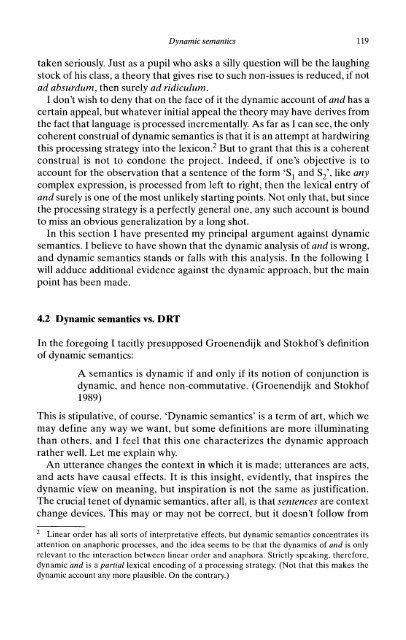Presuppositions and Pronouns - Nijmegen Centre for Semantics
Presuppositions and Pronouns - Nijmegen Centre for Semantics
Presuppositions and Pronouns - Nijmegen Centre for Semantics
You also want an ePaper? Increase the reach of your titles
YUMPU automatically turns print PDFs into web optimized ePapers that Google loves.
Dynamic semantics 119<br />
taken seriously. Just as a pupil who asks a silly question will be the laughing<br />
stock of his class, a theory that gives rise to such non-issues is reduced, if not<br />
ad absurdum, then surely ad ridiculum.<br />
I don't wish to deny that on the face of it the dynamic account of <strong>and</strong> has a<br />
certain appeal, but whatever initial appeal the theory may have derives from<br />
the fact that language is processed incrementally. As far as I can see, the only<br />
coherent construal of dynamic semantics is that it is an attempt at hardwiring<br />
this processing strategy into the lexicon. 2 But to grant that this is a coherent<br />
construal is not to condone the project. Indeed, if one's objective is to<br />
account <strong>for</strong> the observation that a sentence of the <strong>for</strong>m 'Sl x <strong>and</strong> S2', S 2 like any<br />
complex expression, is processed from left to right, then the lexical entry of<br />
<strong>and</strong> surely is one of the most unlikely starting points. Not only that, but since<br />
the processing strategy is a perfectly general one, any such account is bound<br />
to miss an obvious generalization by a long shot.<br />
In this section I have presented my principal argument against dynamic<br />
semantics. I believe to have shown that the dynamic analysis of <strong>and</strong> is wrong,<br />
<strong>and</strong> dynamic semantics st<strong>and</strong>s or falls with this analysis. In the following I<br />
will adduce additional evidence against the dynamic approach, but the main<br />
point has been made.<br />
4.2 Dynamic semantics vs. D DRT<br />
In the <strong>for</strong>egoing I tacitly presupposed Groenendijk <strong>and</strong> Stokhof's definition<br />
of dynamic semantics:<br />
A semantics is dynamic if <strong>and</strong> only if its notion of conjunction is<br />
dynamic, <strong>and</strong> hence non-commutative. (Groenendijk <strong>and</strong> Stokhof<br />
1989)<br />
This is stipulative, of course. 'Dynamic semantics' is a term of art, which we<br />
may define any way we want, but some definitions are more illuminating<br />
than others, <strong>and</strong> I feel that this one characterizes the dynamic approach<br />
rather well. Let me explain why.<br />
An utterance changes the context in which it is made; utterances are acts,<br />
<strong>and</strong> acts have causal effects. It is this insight, evidently, that inspires the<br />
dynamic view on meaning, but inspiration is not the same as justification.<br />
The crucial tenet of dynamic semantics, after all, is that sentences are context<br />
change devices. This mayor may not be correct, but it doesn't follow from<br />
2<br />
2 Linear order has all sorts of interpretative effects, but dynamic semantics concentrates its<br />
attention on anaphoric processes, <strong>and</strong> the idea seems to be that the dynamics of <strong>and</strong> is only<br />
relevant to the interaction between linear order <strong>and</strong> anaphora. Strictly speaking, there<strong>for</strong>e,<br />
dynamic <strong>and</strong> is a partial lexical encoding of a processing strategy. (Not that this makes the<br />
dynamic account any more plausible. On the contrary.)














